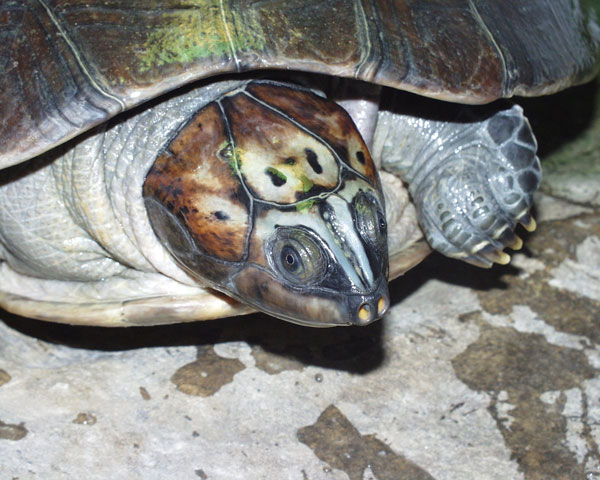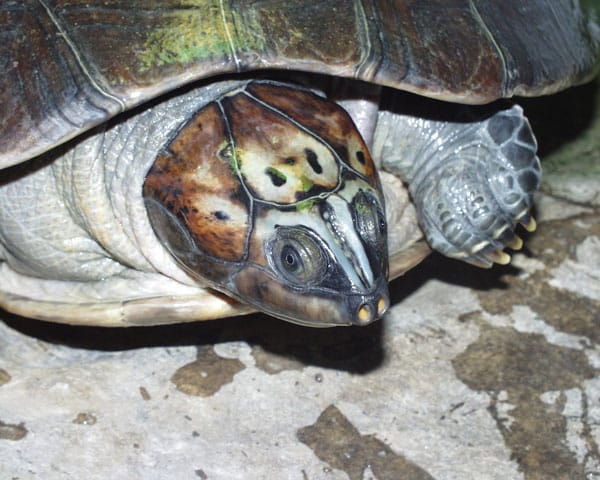Information on giant Amazon River turtle and the yellow-spotted Amazon River turtle.
The giant Amazon River turtle (Podocnemis expansa) and the yellow-spotted Amazon River turtle (P. unifilis) are large river turtles. These impressive turtles have been elusive for turtle keepers in the United States due to legal restrictions. All Podocnemis species are protected as Appendix II species by CITES (Convention on International Trade in Endangered Flora and Fauna) and the impressive P. expansa and the beautiful P. unifilis are on Appendix I of CITES and are both protected by the US Endangered Species Act. This means that specimens, even captive-hatched specimens, cannot cross state lines as a commercial venture without both shipper and receiver having a Captive-Born Wildlife permit.

Photo by Russ Gurley
Podocnemis expansa can get very large, and it requires a large enclosure to accomodate its needs.
The yellow-spotted river turtle (P. unifilis) is found in the Caribbean drainages of Guyana, French Guiana, Venezuela and Colombia, and the upper tributaries of the Amazon River in Colombia, Ecuador, Peru, northern Bolivia, Southern Venezuela and Brazil. It is also established in parts of Florida as a result of escaped or released pets. They probably thrived in the warm waters of southern Florida, and there are no doubt populations living there today. Females of this species can grow to 24 inches and weigh up to 25 pounds. Males reach a smaller adult size. Podocnemis expansa is one of the largest freshwater turtle species on Earth and females can grow to 36 inches long and weigh up to 100 pounds.
The yellow-spotted river turtle has had a strange history in the hobby of reptile keeping. In the days before CITES and the Endangered Species Act, this turtle, with its beautiful yellow and black markings, was an important part of the U.S. pet trade in the 1960s. They provided a stark contrast to the lime green of the little red-eared sliders. Red-eared sliders were the baby turtles available in the local dime stores in the summer, and P. unifilis were available during the winter months. Baby red-ears typically sold for 59 cents, and P. unifilis and the Colombian slider (Trachemys callirostris) sold for 89 cents. Protection under the Endangered Species Act was established in 1970, and the turtle was regulated out of the hobby. Interestingly, the Colombian slider was “protected” by the Endangered Species Act at the same time, preventing both species from being sold within the U.S. There is no doubt in my mind that this regulation was implemented not due to the rarity of these two species but to protect the turtle farmers of the southeastern United States, who were losing sales (at least half of the year) to foreign turtle farmers in South America.
Today, as with all wild turtles and tortoise species worldwide, the threats to Podocnemis species are definitely more real than they were in the 1960s and ‘70s. Podocnemis unifilis and its larger cousin, P. expansa, lay a very large number of eggs. Podocnemis expansa can lay up to 100 eggs, and P. unifilis clutches usually number in the 25 to 30 egg range. Interestingly, these large freshwater river turtles often nest alongside sea turtles on large sandy beaches in much of their range, and in these areas, their eggs have been collected by indigenous people in incredible numbers for centuries. These eggs are eaten by the families of these collectors and many are sold in roadside markets along with bush meat and fruits and vegetables in much of South America. Markets in Peru featured not only eggs of Podocnemis species, but also legs and shells, which are apparently sold as bowls for making soup and other hot dinners over coal fires.
In recent years, an increase in human populations and an increase in tourism to the Amazon River have caused problems for these turtles. Sand beaches have been removed or transformed into fishing camps and a few resorts, impacting the turtles’ ability to lay successful nests. Many are still removed from the waters as food or are caught incidentally by fishing nets and lines of hooks. These turtles are sometimes killed by the fishermen to prevent them from eating more fish or, more likely, taken to the markets as supplemental income.
There has been some passive benefit from ecotourism as more people venture to the Amazon Basin area for boat trips, fishing trips and other adventures. During these journeys, there is at least an increased awareness of the existence of these turtles (and other wildlife) and their important place in the food web of the Amazon River system. There is no doubt that seeing these large, alert, wide-eyed turtles basking on logs or on the backs of black caimans at least produces a desire to protect them for future generations.
Sadly, these large turtles are extremely rare in captivity, even with the increased knowledge of the importance of captive breeding of rare species for future generations. These turtles need specialized facilities to be kept and bred in captivity. They need large ponds with warm water, plenty of aquatic vegetation and sandy areas away from the water for laying eggs. If the water temperatures drop below 50 degrees Fahrenheit, they die. They get large so there is little interest for 95 percent of the reptile hobby because of their need for a very large enclosure. If a large pond and ideal conditions are available, these turtles can be very productive. . . but then what to do with the offspring? They can’t be shipped to other interested parties in states outside where they are produced without a Captive-Born Wildlife permit, and so the breeder is potentially left with many offspring that he or she has to feed and care for. This is also the case with other large species, such as the giant river turtle (Orlitia borneensis), the painted river turtle ( Kachuga [Callagur] borneoensis) and the large, soft-shelled species of southeast Asia.
It is imperative that large numbers of captive-hatched offspring be produced for future reintroduction into nature, but the requirements of these species in captivity to thrive and reproduce is difficult to maintain. One breeder in Florida, who is currently breeding hundreds of Kachuga (Callagur) borneoensis, could probably restock the Perak River in Malaysia with these amazing turtles, but he is limited by what he can do, both physically and financially, with turtles that grow to 24 inches and reach weights of more than 60 pounds.



